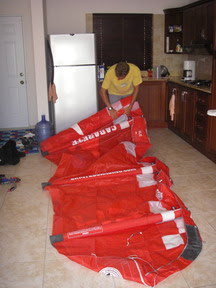I wanted to share a couple photos that I took of Matt's new birthday present (Yes, I know its about a month late!). He got a new 10 meter kite for his birthday to let him sail on windier days. His old kites weren't quite enough to let him sail at all times.
Here he is checking it out in the middle of our apartment.

And... Yes, it folds up to be very compact:

Here are a couple more photos from the past week that I haven't gotten posted yet:
Matt enjoying the beach and waiting for the wind:

Matt & Damien playing with their "inflatable pool toys" on a very light wind day yesterday:

I've finished another layout from our first full day in Athens. I should have another layout to do and that will finish up our first full day there. Boy, I'm never going to get done at this rate.
Here are the two pages joined together:
 Credits:
Credits:Based on a double page sketch by Chris Greiser
Papers, flowers, brads from Traci Sims' kit "Be Free"
Photos by Angela & Matt Shetzer
Fonts: Arial, Century Gothic & Engravers MT
Here is the first page:

Here is the second page:

The journaling reads:
We then headed to the flea market at Monastiriki where we wandered around and stumbled upon the Ancient Agora site. After a great traditional Greek lunch of assorted Greek foods, we set out for the Agora. We visited the Temple of Hephaistos and the Stoa of Attalos. We were trying to figure out what the impressive structure high on the hill was and finally we determined it was the Acropolis.
“The Agora was the heart of ancient Athens, the focus of political, commercial, administrative and social activity, the religious and cultural centre, and the seat of justice. The site was occupied without interruption in all periods of the city's history. It was used as a residential and burial area as early as the Late Neolithic period (3000 B.C.). Early in the 6th century, in the time of Solon, the Agora became a public area.” From: http://odysseus.culture.gr
No comments:
Post a Comment